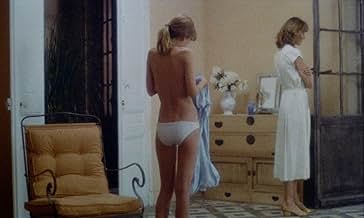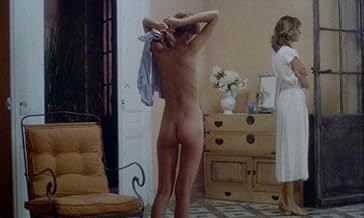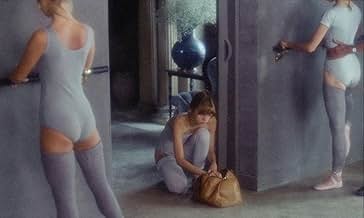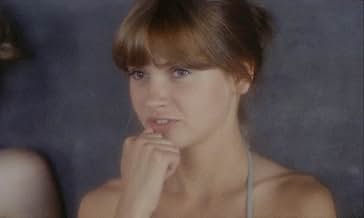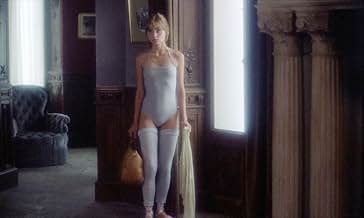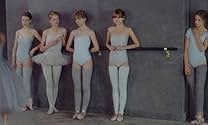VALUTAZIONE IMDb
5,6/10
1554
LA TUA VALUTAZIONE
Lo scultore Paul incontra di nuovo un ex grande amore dopo tanto tempo, ma è molto più colpito dalla figlia di 15 anni, Laura.Lo scultore Paul incontra di nuovo un ex grande amore dopo tanto tempo, ma è molto più colpito dalla figlia di 15 anni, Laura.Lo scultore Paul incontra di nuovo un ex grande amore dopo tanto tempo, ma è molto più colpito dalla figlia di 15 anni, Laura.
- Regia
- Sceneggiatura
- Star
William Milié
- Le chorégraphe
- (as William Millie)
Gunilla Astrom
- Diane
- (non citato nei titoli originali)
Bernard Daillencourt
- Docteur Benoît
- (non citato nei titoli originali)
David Hamilton
- Un invité à la réception
- (non citato nei titoli originali)
Katia Kofet
- Claudie
- (non citato nei titoli originali)
Luciano
- Timothez Sega
- (non citato nei titoli originali)
Michael Pochna
- Gérard
- (non citato nei titoli originali)
Anja Schüte
- Dancer
- (non citato nei titoli originali)
Recensioni in evidenza
I agree more or less with all the comments sent so far. This might be surprising, because they seem to be so different. But they are sent from different points of view, and if you try to make a resume, you'll see how it all fits well. Let's make an example: "Glengarry Glen Ross" (or some similar indoor drama) can be described as perfect deep (by drama lovers) or terribly unwatchable slow boring movie (by action lovers); great example how a masterpiece can be made without a single female role (artistic purist statement), or a glorifying men in business and so neglecting women (a feminist statement) or even a pointless flick with no chicks to look at (a macho statement); a movie where authors bravely use words that people use in reality, or a blasphemy with an obscene language that would fit only in NC-17 movie.
I admire and adore Hamilton's work as a photograph. But, yes, being a genius in one art doesn't automatically mean you can make masterpieces in other arts (Barbara Streissand is an exemption). Some great movie photographers made movies (like Nykvist), but they learned job with people like Tarkovsky. Hamilton made only still pictures, and this is what he does best. I think making movies was not a bad idea, but he should have made them as a photographer and leave directing to a professional. Then he could have avoided some real mistakes described in earlier comments. But I wouldn't be too strict. If you don't expect too much his movies won't disappoint you. Of course, if you don't accept nudity, this is not a movie for you, but such audience knows they should avoid Hamilton's work in general. People who believe showing nude young bodies is a sin are entitled to their opinions; but if you believe such a movie could induce child molestation, you should also ban all crime movies, thrillers (not to mention horrors), movies where people smoke, eat fast food, hurt each other in any way, appear in dangerous situations (most adventure movies from Tom Sawyer and Tarzan to Indiana Jones) etc. - such behaving can also be imitated, even more dangerously (there is no violence in Hamilton's movies!). And a man who can't tell reality from a movie is a psychopath who will cross the line of crime sooner or later regardless the movies he watches.
Back to Laura and Hamilton. In Laura he made probably his most beautiful scenes, like Laura going out from the sea, and the opening sequences are his typical. And the scene some don't like, some find controversial, when Laura dances and her mother takes pictures, is a real homage to photography as art. It is an artist-model and not a mother-daughter relation. With a photo (or pencil, or canvas) in his hand an artist leaves his real world, stops being a member of family, race, nation, he creates a new world. Here Hamilton gives us a short lesson of making photos, feeling the light (Hamilton's strongest tool), lines, movements. If a picture paints a thousand words this scene saves a million words if you want to make a documentary about Hamilton himself. And this is where I agree with some of earlier comments, his work talks enough, he should stay behind camera. No words. Less directing.
A film, though with weak script and much too big oscillations in directing, was saved by great acting and again (like in Bilitis) by perfect music. For Hamilton fans - don't expect "La Dance" or "Dreams of a Young Girl", but you'll like it. The others, if not too easily offended, probably won't turn the TV off, but it's also very likely they won't remember it too long.
I admire and adore Hamilton's work as a photograph. But, yes, being a genius in one art doesn't automatically mean you can make masterpieces in other arts (Barbara Streissand is an exemption). Some great movie photographers made movies (like Nykvist), but they learned job with people like Tarkovsky. Hamilton made only still pictures, and this is what he does best. I think making movies was not a bad idea, but he should have made them as a photographer and leave directing to a professional. Then he could have avoided some real mistakes described in earlier comments. But I wouldn't be too strict. If you don't expect too much his movies won't disappoint you. Of course, if you don't accept nudity, this is not a movie for you, but such audience knows they should avoid Hamilton's work in general. People who believe showing nude young bodies is a sin are entitled to their opinions; but if you believe such a movie could induce child molestation, you should also ban all crime movies, thrillers (not to mention horrors), movies where people smoke, eat fast food, hurt each other in any way, appear in dangerous situations (most adventure movies from Tom Sawyer and Tarzan to Indiana Jones) etc. - such behaving can also be imitated, even more dangerously (there is no violence in Hamilton's movies!). And a man who can't tell reality from a movie is a psychopath who will cross the line of crime sooner or later regardless the movies he watches.
Back to Laura and Hamilton. In Laura he made probably his most beautiful scenes, like Laura going out from the sea, and the opening sequences are his typical. And the scene some don't like, some find controversial, when Laura dances and her mother takes pictures, is a real homage to photography as art. It is an artist-model and not a mother-daughter relation. With a photo (or pencil, or canvas) in his hand an artist leaves his real world, stops being a member of family, race, nation, he creates a new world. Here Hamilton gives us a short lesson of making photos, feeling the light (Hamilton's strongest tool), lines, movements. If a picture paints a thousand words this scene saves a million words if you want to make a documentary about Hamilton himself. And this is where I agree with some of earlier comments, his work talks enough, he should stay behind camera. No words. Less directing.
A film, though with weak script and much too big oscillations in directing, was saved by great acting and again (like in Bilitis) by perfect music. For Hamilton fans - don't expect "La Dance" or "Dreams of a Young Girl", but you'll like it. The others, if not too easily offended, probably won't turn the TV off, but it's also very likely they won't remember it too long.
David Hamilton established his name as a fashion photographer through the still, dreamy soft focus images of young girls, usually portrayed in muted colours, for which he has become famous. At some point he appears to have decided that this experience was all he needed to produce great movies, and he started to direct films that characteristically show all the same features as his fashion images. Unfortunately these were not generally well received and some critics have suggested that he has only a rudimentary appreciation of how to blend successive still images into an ongoing movie sequence. Personally I greatly enjoy his still fashion photography and this enjoyment is sufficient for me to also appreciate his films - overlooking any faults in their dynamics. His best known film is probably "Bilitis", a study of a young girl coming of age, but my preference is for "Laura", a film about a young girl modeling for a sculptor who is blinded in a fire. We can, I hope, ignore comments on the IMDb database which suggest that there is something sinister in Hamilton's preference for models and actresses who appear very young. In his films his objective is to create a story which has a strong emotional appeal but which is also visually beautiful to watch. My judgment is that Laura achieves this objective superbly. One sequence which haunts my memory as much as any other film sequence I have ever seen; comes towards the end of this film. It shows the sculptor, nearly blinded by the fire, returning to his almost finished sculpture whilst he explores the torso of his model with an extended finger trying to recreate in his mind the beauty that he can no longer see.
My recommendation would be to watch this film, which is not readily obtainable today, as soon as any opportunity arises.
POSTSCRIPT - added January 2005
This film has - to my surprise - now been released as a DVD. If these various very different assessments intrigue you in any way, why not buy a copy and add your comments to those already here?
My recommendation would be to watch this film, which is not readily obtainable today, as soon as any opportunity arises.
POSTSCRIPT - added January 2005
This film has - to my surprise - now been released as a DVD. If these various very different assessments intrigue you in any way, why not buy a copy and add your comments to those already here?
David Hamilton's "Laura" has got to be one of the most gorgeous erotic films of all time. The story of a young girl's sexual awakening is a rather simple one, and certainly more based on fantasy (more specifically, 'male fantasy') than reality. 15 year-old Laura (Dawn Dunlap) lives in a pastel world where everything is white, everyone is beautiful, and nothing is quite real. Laura develops a fascination with the much older Paul, a sculptor with an eye for a special kind of beauty. The conflict here, is that Paul is the former lover of Laura's mother Sara, (Maud Adams). Here develops a classic situation of mother/daughter competition. When Paul sees the beautiful Laura, he is smitten, at the girls beauty, and also at how she resembles Sara, at age 15. Sara's attempts to keep the two separate are not entirely successful. Filmed on the French Riviera, in soft focus style, by renowned photographer Hamilton, you can imagine the look of the film, if you are familiar with his work. It is strange, quiet, dreamlike, quite unlike anything i have seen before. Quite controversial too. Dawn Dunlap, who was not so much older than the character she played, is very graceful and nice to look at, and former Bond girl Maud Adams is incredibly beautiful in this one as well. Although the character of Paul, (James Mitchell) is supposed to be close to 50 years old, the relationship between him and Laura is not so hard to take, as he is also a very handsome guy, who looks nowhere near his age. Also worthy of mention is the lush, dreamlike soundtrack that accompanies these images. One scene that stands out is a dream sequence; Filmed in black & white, Laura is running through a maze of little streets and alleys, looking for Paul, but he continues to allude her. Very nicely done. Hamilton creates a kind of quiet suspense, as the viewer waits for the time when the two get together. While there is nudity in the film, it is all done with the utmost of taste and subtlety. One thing: I cannot stress how important it is when watching this film, that you see the original French language version. The English dubbing for this one is wretched, absolutely dire. It is not even proper English, but American English, and it totally destroys the feeling and tone of this very French film. I first saw it in English, and I didn't think too much of the film, as the visuals were great, but the voices and dialog were so bad. When i saw the French version, it was like another experience entirely. Usually i don't mind voice dubbing so much, but here it is intolerable. I think that a lot of reviewers here have only seen the easier to find English version, which might explain the films low rating. "Laura" is a very classy erotic film, in it's original French language.
Artists are inspired by myths, and this picture-poem starts with an artist having a visionary view of the birth of Venus. To director David Hamilton this is a look at a woman before life leaves its many marks on her. Both Hamilton and the artist wants to freeze this moment of Adam-and-Eve-innocence, and both do it with sensual devotion. The innocence gets lost on the way, as we all know it will be - but in Hamiltons dream, as well as in his life as photographer, the sensuality not only remains, but grows stronger. Maud Adams shows as mother a strong believe in this, watching her daughter growing up. As the daughter, Laura, sees Dawn Dunlap.
Other comments shows too much interest for the amateurish acting in this picture-poem. As a mirror reflecting a world where we think too much and too little at the same time. We think too much with our senses turned off, and too little with our senses turned on. Brigitte Bardot was once asked by a journalist: "What do you think about free love?" Brigitte Bardot answered: "I don't think when I make love". If Hamilton was asked about his movie-theory for "Laura", he would probably answer: "I don't make movies, I'm just dreaming". The camera catch the dream and makes it possible to share it - and I'm very grateful that it has been possible for me to share Hamilton's dream.
David Hamilton is a child of a time - the 70's - where everybody was searching deep and wide, and he became famous in that time. Men like to see his pictures of girls, but back then it was the mothers who asked him to photograph their daughters. The style in Hamilton's picture-poems was not unusual for European movies in the 70's. A danish movie was inspired by Robert Frost: "The woods are lovely dark and deep / but I have promises to keep / and miles to go before I sleep." Perhaps the meaning in that poem is the reason why Hamilton wants to share his dreams.
Other comments shows too much interest for the amateurish acting in this picture-poem. As a mirror reflecting a world where we think too much and too little at the same time. We think too much with our senses turned off, and too little with our senses turned on. Brigitte Bardot was once asked by a journalist: "What do you think about free love?" Brigitte Bardot answered: "I don't think when I make love". If Hamilton was asked about his movie-theory for "Laura", he would probably answer: "I don't make movies, I'm just dreaming". The camera catch the dream and makes it possible to share it - and I'm very grateful that it has been possible for me to share Hamilton's dream.
David Hamilton is a child of a time - the 70's - where everybody was searching deep and wide, and he became famous in that time. Men like to see his pictures of girls, but back then it was the mothers who asked him to photograph their daughters. The style in Hamilton's picture-poems was not unusual for European movies in the 70's. A danish movie was inspired by Robert Frost: "The woods are lovely dark and deep / but I have promises to keep / and miles to go before I sleep." Perhaps the meaning in that poem is the reason why Hamilton wants to share his dreams.
Laura, Les Ombres De L'ete
David Hamilton does a great job expressing his seeming obsession with pre-pubescent ballet dancers in Laura, Les Ombres De L'ete. Possibly one of the worst (and most boring) "art house" pictures ever made, professional photographer/amateur filmmaker Hamilton drowns in his excessive use of soft focus, pseudo-artistic fadeouts, and nudity, devices employed to make up for the shallow plot.
After seeing teenaged Laura (Dawn Dunlap) at ballet class, sculptor Paul Thomas Wyler (James Mitchell) knows that he must sculpt this beautiful little girl, just as he had done with her mother Sarah (Maud Adams) 20 or so years prior. But Sarah can see through his superficial intentions and tries her best to keep her very curious daughter from posing for this oh-so-artistic womanizer.
Laura contains several sequences of excessive nudity (mostly of young Dunlap) and there is no doubt that Hamilton's subjects are quite attractive; in fact, the photo-shoot scenes, with Sarah taking endless pictures of her naked daugher prancing around (including a few gymnastic poses), are certainly provocative. But like Hamilton's other exploitative French productions, the story is built around these sequences and without them there is little else to interest the viewer. The film comes across as heavy-handed, pretentious, and, ultimately, empty. Some termed this soft-core when it was released but the film simply isn't graphic enough to qualify for the category. -- David Ross Smith
David Hamilton does a great job expressing his seeming obsession with pre-pubescent ballet dancers in Laura, Les Ombres De L'ete. Possibly one of the worst (and most boring) "art house" pictures ever made, professional photographer/amateur filmmaker Hamilton drowns in his excessive use of soft focus, pseudo-artistic fadeouts, and nudity, devices employed to make up for the shallow plot.
After seeing teenaged Laura (Dawn Dunlap) at ballet class, sculptor Paul Thomas Wyler (James Mitchell) knows that he must sculpt this beautiful little girl, just as he had done with her mother Sarah (Maud Adams) 20 or so years prior. But Sarah can see through his superficial intentions and tries her best to keep her very curious daughter from posing for this oh-so-artistic womanizer.
Laura contains several sequences of excessive nudity (mostly of young Dunlap) and there is no doubt that Hamilton's subjects are quite attractive; in fact, the photo-shoot scenes, with Sarah taking endless pictures of her naked daugher prancing around (including a few gymnastic poses), are certainly provocative. But like Hamilton's other exploitative French productions, the story is built around these sequences and without them there is little else to interest the viewer. The film comes across as heavy-handed, pretentious, and, ultimately, empty. Some termed this soft-core when it was released but the film simply isn't graphic enough to qualify for the category. -- David Ross Smith
Lo sapevi?
- QuizWhen Laura is in the ballet shower, many of the poses duplicate paintings of Edgar Degas (an artist famed for his ballerina portraits).
- Versioni alternativeThe German cut is ten minutes shorter than the regular version at 85 mins.
I più visti
Accedi per valutare e creare un elenco di titoli salvati per ottenere consigli personalizzati
- How long is Laura?Powered by Alexa
Dettagli
Contribuisci a questa pagina
Suggerisci una modifica o aggiungi i contenuti mancanti

Divario superiore
What is the Hindi language plot outline for Laura, primizie d'amore (1979)?
Rispondi
